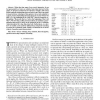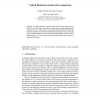493 search results - page 15 / 99 » Representing preferences using intervals |
GECCO
2004
Springer
14 years 1 months ago
2004
Springer
This paper proposes an experimental evaluation of various discretization schemes in three different evolutionary systems for inductive concept learning. The various discretization...
CPM
2004
Springer
14 years 1 months ago
2004
Springer
A popular approach in comparative genomics is to locate groups or clusters of orthologous genes in multiple genomes and to postulate functional association between the genes contai...
PRL
2006
13 years 7 months ago
2006
This paper presents a partitional dynamic clustering method for interval data based on adaptive Hausdorff distances. Dynamic clustering algorithms are iterative two-step relocatio...
TFS
2008
13 years 7 months ago
2008
When the time span of an event is imprecise, it can be represented by a fuzzy set, called a fuzzy time interval. In this paper, we propose a framework to represent, compute, and re...
SUM
2007
Springer
14 years 1 months ago
2007
Springer
Abstract. The paper presents a valued extension of the recently introduced concept of PQI interval order. The main idea is that, while comparing objects represented by interval of ...


